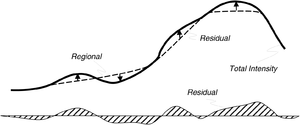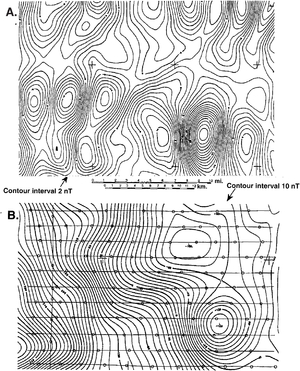Difference between revisions of "Magnetics: total intensity and residual magnetic maps"
FWhitehurst (talk | contribs) |
Cwhitehurst (talk | contribs) m (added Category:Treatise Handbook 3 using HotCat) |
||
| (6 intermediate revisions by 2 users not shown) | |||
| Line 21: | Line 21: | ||
==What is residual?== | ==What is residual?== | ||
| − | [[file:using-magnetics-in-petroleum-exploration_fig14-2.png|thumb|300px|{{figure number|1}}Magnetic profiles of total intensity, regional trend, and residual. After Nettleton.<ref name=ch14r7>Nettleton, 1962, Elementary Gravity and Magnetics for Geologists and Seismologists: Society of Exploration Geophysicists Monograph Series 1, 121 p.</ref> Copyright: Society of Exploration Geophysicists.]] | + | [[file:using-magnetics-in-petroleum-exploration_fig14-2.png|thumb|300px|{{figure number|1}}Magnetic profiles of total intensity, regional trend, and residual. After Nettleton.<ref name=ch14r7>Nettleton, L. L., 1962, Elementary Gravity and Magnetics for Geologists and Seismologists: Society of Exploration Geophysicists Monograph Series 1, 121 p.</ref> Copyright: Society of Exploration Geophysicists.]] |
| − | Residual is what remains after regional magnetic trends are removed from the total intensity Residual maps show local magnetic variations, which may have exploration significance. The regional trend of the total intensity can be calculated using a number of techniques, including running averages, polynomials, low-pass filters, or upward continuation techniques. [[:file:using-magnetics-in-petroleum-exploration_fig14-2.png|Figure 1]] shows magnetic profiles of total intensity, regional trend, and residual. | + | Residual is what remains after regional magnetic trends are removed from the total intensity Residual maps show local magnetic variations, which may have exploration significance. The regional trend of the total intensity can be calculated using a number of techniques, including running averages, polynomials, low-pass filters, or [http://wiki.seg.org/wiki/Dictionary:Upward_continuation upward continuation] techniques. [[:file:using-magnetics-in-petroleum-exploration_fig14-2.png|Figure 1]] shows magnetic profiles of total intensity, regional trend, and residual. |
==Total intensity and residual map example== | ==Total intensity and residual map example== | ||
| Line 31: | Line 31: | ||
The maps in [[:file:using-magnetics-in-petroleum-exploration_fig14-3.png|Figure 2]] are examples of a residual map (A) that was calculated from the total intensity magnetic map (B). The grid and small circles on the total intensity map are the flight path lines [approximately [[length::2 km]] (1.2 mi) apart] and location points for the flight lines. The total intensity map strikingly does not resemble the residual map and would be of limited value for delineating basement fault blocks. | The maps in [[:file:using-magnetics-in-petroleum-exploration_fig14-3.png|Figure 2]] are examples of a residual map (A) that was calculated from the total intensity magnetic map (B). The grid and small circles on the total intensity map are the flight path lines [approximately [[length::2 km]] (1.2 mi) apart] and location points for the flight lines. The total intensity map strikingly does not resemble the residual map and would be of limited value for delineating basement fault blocks. | ||
| − | Total intensity [[magnetics]] responds to rock types over broad areas as well as those deep within the crust. We can see by a careful examination of map B, however, that many of the features shown by the residual map are vaguely apparent in the total intensity data. Fortunately, we no longer have to interpret such total intensity maps in petroleum basins because many enhancement techniques employing residuals, derivatives, polynomials, or downward continuation exist to reveal the subtle magnetic anomalies that result from the changes in rock type across basement block boundaries. | + | Total intensity [[magnetics]] responds to rock types over broad areas as well as those deep within the [[crust]]. We can see by a careful examination of map B, however, that many of the features shown by the residual map are vaguely apparent in the total intensity data. Fortunately, we no longer have to interpret such total intensity maps in petroleum basins because many enhancement techniques employing residuals, derivatives, polynomials, or [http://wiki.seg.org/wiki/Dictionary:Downward_continuation downward continuation] exist to reveal the subtle magnetic anomalies that result from the changes in rock type across basement block boundaries. |
==See also== | ==See also== | ||
| Line 37: | Line 37: | ||
* [[Magnetic field: local variations]] | * [[Magnetic field: local variations]] | ||
* [[Magnetics: petroleum exploration applications]] | * [[Magnetics: petroleum exploration applications]] | ||
| + | * [[Magnetics: interpreting residual maps]] | ||
==References== | ==References== | ||
| Line 48: | Line 49: | ||
[[Category:Predicting the occurrence of oil and gas traps]] | [[Category:Predicting the occurrence of oil and gas traps]] | ||
[[Category:Using magnetics in petroleum exploration]] | [[Category:Using magnetics in petroleum exploration]] | ||
| + | [[Category:Treatise Handbook 3]] | ||
Latest revision as of 19:55, 27 January 2022
| Exploring for Oil and Gas Traps | |

| |
| Series | Treatise in Petroleum Geology |
|---|---|
| Part | Predicting the occurrence of oil and gas traps |
| Chapter | Using magnetics in petroleum exploration |
| Author | Edward A. Beaumont, S. Parker Gay |
| Link | Web page |
| Store | AAPG Store |
Magnetic variation or susceptibility may be analyzed using either total intensity or residual maps. Magnetic residual maps reveal much more detailed geologic features—in particular, the geometry and configuration of individual basement blocks. They bring out the subtle magnetic anomalies that result from the changes in rock type across basement block boundaries. Total intensity maps show larger scale geologic features, such as basin shape or anomalous rock types deep within the basement.
What is total intensity?
Total intensity is the measurement from the magnetometer after a model of the earth's normal magnetic field is removed. It is generally a reflection of the average magnetic susceptibility of broad, large-scale geologic features.
What is residual?

Residual is what remains after regional magnetic trends are removed from the total intensity Residual maps show local magnetic variations, which may have exploration significance. The regional trend of the total intensity can be calculated using a number of techniques, including running averages, polynomials, low-pass filters, or upward continuation techniques. Figure 1 shows magnetic profiles of total intensity, regional trend, and residual.
Total intensity and residual map example

The maps in Figure 2 are examples of a residual map (A) that was calculated from the total intensity magnetic map (B). The grid and small circles on the total intensity map are the flight path lines [approximately length::2 km (1.2 mi) apart] and location points for the flight lines. The total intensity map strikingly does not resemble the residual map and would be of limited value for delineating basement fault blocks.
Total intensity magnetics responds to rock types over broad areas as well as those deep within the crust. We can see by a careful examination of map B, however, that many of the features shown by the residual map are vaguely apparent in the total intensity data. Fortunately, we no longer have to interpret such total intensity maps in petroleum basins because many enhancement techniques employing residuals, derivatives, polynomials, or downward continuation exist to reveal the subtle magnetic anomalies that result from the changes in rock type across basement block boundaries.
See also
- Magnetics
- Magnetic field: local variations
- Magnetics: petroleum exploration applications
- Magnetics: interpreting residual maps
References
- ↑ Nettleton, L. L., 1962, Elementary Gravity and Magnetics for Geologists and Seismologists: Society of Exploration Geophysicists Monograph Series 1, 121 p.
- ↑ Gay, S. P., Jr., 1995, The basement fault block pattern: its importance in petroleum explo- ration, and its delineation with residual aeromagnetic techniques, in R. W. Ojakangas, ed., Proceedings of the 10th International Basement Tectonics Conference, p. 159–207.